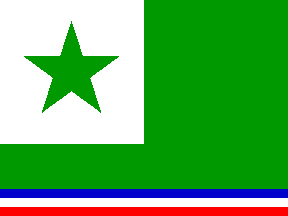
Last modified: 2009-03-14 by antónio martins
Keywords: esperanto | star: 5 points (green) | canton: star | e | jubilea simbolo | ee | verda stelo | contest |
Links: FOTW homepage |
search |
disclaimer and copyright |
write us |
mirrors

Esperanto accounts for more than 99% of all published
material on interlinguistics, and probbably much more than
99% of the speakers of all constructed languages.
António Martins, 04 June 1999
The Esperanto flag: green 2:3, white 1:1 canton with
0,35 radius green 5 pointed regular star pointing upwards
centered on it.
António Martins, 04 Jun 1999
Esperanto organizations and individual esperantists use this
flag as a general symbol of their language; variants defaced with
organization names and slogans, written on the bottom half of the
flag, are usual.
Some organizations, especially those whose logo or emblem is based
on the green star, put it on the canton of an otherwise unmodified
esperanto flag (see particular variants).
António Martins, 14 May 2004
According to [rod97], both a star and the green color were associated to Esperanto quite early, following a call for it from B. G. Jonson, a Swedish Esperantist. Louis de Beaufront (who later become adept of Ido) proposed and initiated the usage of publishing books written in Esperanto with their covers green and with a star on it. The idea caught on and soon the green color and the star symbol were all over in Esperanto written books and periodicals. However nothing was fixed for the exact design of the star neither for its color — it was often golden, on the green background.
In 1893, were used the first lapel pins with a green star on a white background, by C. Rjabinis and P. Deullin, in a design used until today. The meaning of this symbol was, as usual, coined a posteriori — said to stand for the hope (green) of the five continents untited (5-pointed star) in common understanding and peace (white color)…
António Martins, 04 Jun 1999
Some organizations, especially those whose logo or emblem is based
on the green star, put it on the canton of an otherwise unmodified
esperanto flag.
António Martins, 14 May 2004

Christian esperantists of most denominations use Esperanto’s
star defaced with a cross outline in pins and emblems. Some flags show this
on the usual canton, with or without lettering in the lower fly.
António Martins, 14 May 2004

An exception to this seems to be left wing
esperantists, on record for seldom usage of a regular
esperanto flag with green star on the white canton of a
red flag, instead of green.
This may stem from the green star fimbriated red that makes the emblem
of SAT (Sennacieca Asocio Tutmonda), a political organization for
left-wing esperantists, encompassing all tendences except (until recently)
communists (marxist-leninist and maoist sorts).
António Martins, 14 May 2004

Perhaps because the star is a very “plain” logo, easy to confuse especially in black-and-white medium, it is quite often to deface the star with a white upper case "E", of obvious meaning. This however is seldom done in flags, perhaps because the complete design (field, canton and star) is less confuseable than an isolated star.
There are however some cases of flags with "E"-stars, some dating back to the earlier days of Esperanto, as the one above, from a photo taken in the II Esperanto World Congress, in Dresden (Germany), 1908.
António Martins, 16 Mar 2004

Still according to [rod97],
the Esperanto flag was approved during the 1.st Esperanto
Universal Congress, in 1905, held at Boulogne-sur-Mer (France).
Originnally the flag of the local Esperanto Club, who organized
the congress, it had a design similar to the one in current use:
The main differences in respect to the current
flag are the proportions — it is described as being 120 cm
wide and with a top hoist canton of 50×50 cm. Since nothing
is said about the height, the image above was made in 9:12,
with a 6:6 canton, which more or less coincides with my
recollection of old photos. (Star in the current 70% ratio.)
António Martins, 04 Jun 1999

Rodríguez [rod97] says that
Duchois, Michaux and Sargeant, main organizers of the congress,
considered the adoption of a french tricolor
stripe, but soon rejected it. I can see the motive for the refusal
(a national, not an international symbol), but not for the proposal!
I guess the original club flag lacked this stripe and the image above
shows it in the bottom in short of any better idea (though this
is more a yugoslavian tricolor…)
António Martins, 04 Jun 1999

The new jubilee symbol (jubilea simbolo), was chosen in contest by the Universal Esperanto Association while preparing the first centenial of the language, in 1987. Called derogatively by some as the melono (mellon), it was designed by a Brazilian esperantist.
While it was not aimed to replace the green star, this logo grew well outside its original usage scope. Even if today it is half forgotten, it knew a quite wide usage during the 1990’ies, especialy by “modern” Esperantists — while traditionalist ones felt some discontempt towards this new logo, who “menaced” to replace the role of nia kara stelo. Since one of the “behavior” differences between these two groups was the almost complete avoidance of pins, flags and other “eccentric looking” displays by the “modernists” (contrasting with a frequently ridiculous and folkloric ornamentation used by the “traditionalists”, namely in flags), the new symbol was quite seldom used in flags, but some in-betweeners of these two tendences soon adapted the new symbol in the old-style usage, of which the flag design above was one of the main examples. (Note that here I’ve over-simplified the quite complex micro-social situation of the current esperanto-speaking community.)
António Martins, 04 June 1999
Anything below this line was not added by the editor of this page.